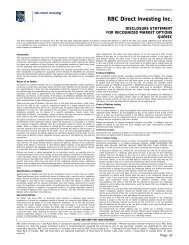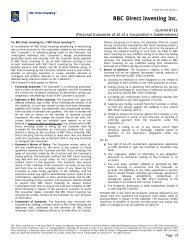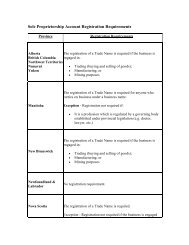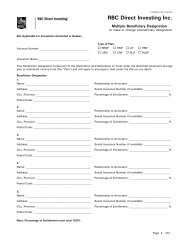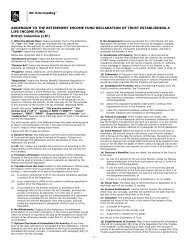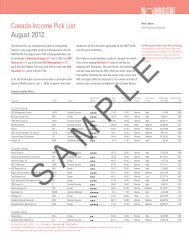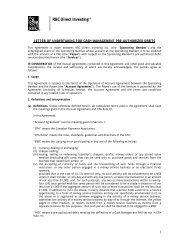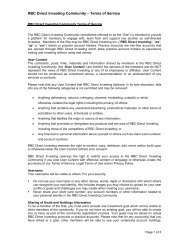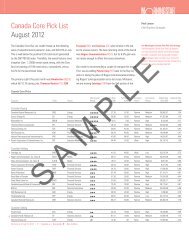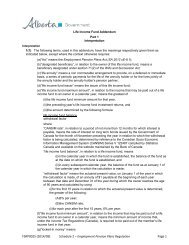View Sample PDF - RBC Direct Investing
View Sample PDF - RBC Direct Investing
View Sample PDF - RBC Direct Investing
Create successful ePaper yourself
Turn your PDF publications into a flip-book with our unique Google optimized e-Paper software.
Global Investment Outlook • Eric Lascelles • Daniel E. Chornous, CFA • John Richards<br />
and the corrosive effect of deepening<br />
recession. China is also manifestly<br />
slowing, with an uncertain trajectory.<br />
The U.S. grapples once again with its<br />
debt ceiling this fall and confronts a<br />
sheer fiscal cliff at year-end. Together,<br />
this imperilled trio – the Eurozone,<br />
China and America – make up fully half<br />
of the global economy.<br />
For all the fear-mongering and even our<br />
own below-consensus forecasts, let us<br />
be clear that these are risks and not<br />
realities. In each case, we anticipate<br />
rather more benign outcomes than the<br />
worst-case scenarios discussed here.<br />
The winning investing strategy over<br />
the past several years – despite the<br />
many risks throughout – has been to<br />
maintain a steady keel.<br />
Unsung heroes<br />
Policymakers continue to be the<br />
unsung heroes in this era of discontent,<br />
delivering additional stimulus whenever<br />
the situation has demanded it. Real<br />
interest rates remain outright negative<br />
(Exhibit 5). They are a key reason why<br />
worst-case scenarios have generally<br />
not transpired. Lately, great gobs of<br />
monetary stimulus have been ladled<br />
onto emerging nations, adding to the<br />
stimulative elixir already brewing in<br />
developed nations. There remains<br />
a good chance that more monetary<br />
stimulus may yet be conjured in the<br />
developed world, too.<br />
In contrast, fiscal policy has its back<br />
up against the wall in many parts of<br />
the world, and is unable to materially<br />
improve growth without risking an even<br />
larger debt problem. This represents a<br />
constraint that did not exist in 2008<br />
or 2009.<br />
EXHIBIT 5.<br />
Global Real Policy Rate (%)<br />
5<br />
4<br />
3<br />
2<br />
1<br />
0<br />
-1<br />
-2<br />
2000 2002 2004 2006 2008 2010 2012<br />
Regions included: U.S., Canada, U.K., Eurozone, Switzerland, Sweden, Norway,<br />
Japan, Australia, China, India, South Korea, Russia, Brazil, Mexico. PPP weights by<br />
GDP share. Source: Haver Analytics, <strong>RBC</strong> GAM<br />
EXHIBIT 6. Fiscal Drag in 2012<br />
Eurozone<br />
Germany<br />
France<br />
Greece<br />
Italy<br />
Spain<br />
Portugal<br />
Global Real Monetary Policy Rate<br />
0.4<br />
0.9<br />
0.9<br />
2.2<br />
2.5<br />
3.1<br />
3.3<br />
0 1 2 3 4<br />
Change in Budget Balance as a % of GDP<br />
Note: A positive number is a reduction in budget balance in 2012 compared to 2011.<br />
Source: International Monetary Fund, Haver Analytics, <strong>RBC</strong> GAM<br />
SAMPLE<br />
European recession as<br />
easy as 1-2-3<br />
Europe has now indisputably tumbled<br />
into recession. The trio of fiscal<br />
austerity, rock-bottom confidence and<br />
weakening credit have seen to that.<br />
While fiscal austerity is biting hard<br />
in several peripheral European<br />
nations, the Eurozone-wide drag is not<br />
particularly overwhelming due to far<br />
smaller drags among large members<br />
like Germany and France. We expect<br />
that fiscal austerity will subtract no<br />
more than a percentage point from<br />
overall Eurozone GDP growth in 2012<br />
and 2013 (Exhibit 6).<br />
Consumer and investor confidence is<br />
low in Europe, translating into a dearth<br />
of risk-taking and a concomitant safehaven<br />
bid for bonds (Exhibit 7).<br />
Hardly the most obvious, but possibly<br />
the most pernicious, drag on European<br />
growth is the scourge of poor credit<br />
conditions. Banks and financial<br />
markets are increasingly unwilling to<br />
extend credit within Europe (Exhibit 8).<br />
The global investment outlook <strong>RBC</strong> INVESTMENT Strategy coMMITTEE Summer 2012 I 13



